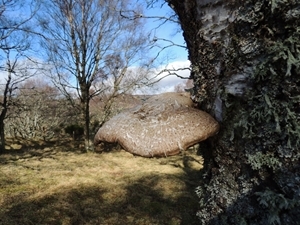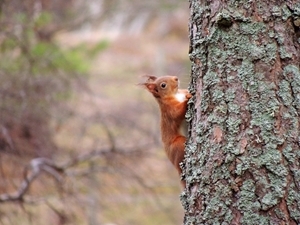There are two distinct types of woodland found at Auchnerran: grazable woodland and commercial woodland.
Grazable woodland
 Auchnerran’s semi-natural woodlands are a complex range of habitats, rich in wildlife. Found mostly at the southern end of the farm they are typically sparse native birch, rowan, alder and pine cover with rough grass clearings and gorse, bracken and broom stands.
Auchnerran’s semi-natural woodlands are a complex range of habitats, rich in wildlife. Found mostly at the southern end of the farm they are typically sparse native birch, rowan, alder and pine cover with rough grass clearings and gorse, bracken and broom stands.
Many of these woodlands are on drier knolls of ground which are attractive to gamebirds. Monitoring has shown that woodcock value these areas with a high density of roding cocks (breeding males).
These woodlands have not been utilised for grazing due to the lack of suitable fencing, however now that the farm has entered the Agri-Environment Climate Scheme (AECS) it has enabled the farm to erect a further 7000 m of fencing. Grazing in these now fenced woodland areas will begin in the later months of 2019 and provide a substantial increase of forage for the expanding flock.
The mix of farming and tree growth is historical in this area, but it is increasingly of interest in the policy and practical contexts of ‘agroforestry’. At Auchnerran the management of these woods needs to balance:
- Providing enough grazing for sheep to be a useful forage resource, without damaging the biodiversity of the understory.
- Controlling sheep movement within the large, hard to gather woodland areas.
- Monitoring the interaction with deer and rabbit grazing.
- Controlling the pickup of ticks and other parasites in the woodland environment.
Commercial woodland
 The remainder of the wooded areas are being maintained as commercial woodland consisting of Scots pine, Norway spruce and Sitka spruce. The dense canopy makes them an ideal habitat for red squirrels as well as popular shelter for deer and birds, including raptors.
The remainder of the wooded areas are being maintained as commercial woodland consisting of Scots pine, Norway spruce and Sitka spruce. The dense canopy makes them an ideal habitat for red squirrels as well as popular shelter for deer and birds, including raptors.
Our baseline monitoring suggests that red squirrels and pine marten value these habitats.
The mix of farming and forestry is common in the area, and the importance of forestry as an additional income generator for farmers is predicted to grow due to demand for sustainable, renewable materials for the biofuels market.
It is a priority to manage our commercial woodlands sympathetically, both for nature conservation and timber production. Specific biodiversity aims can be achieved by accessing government grants for planting new woodlands or managing existing ones.